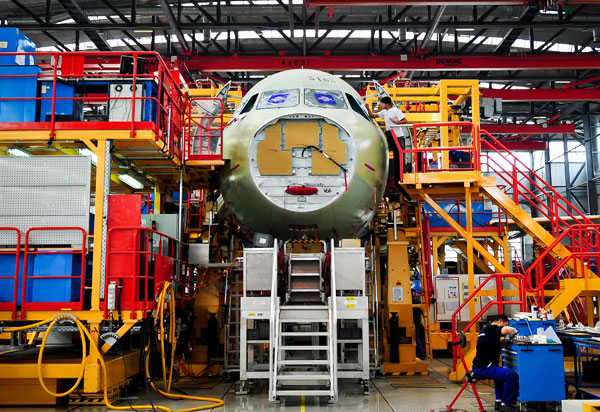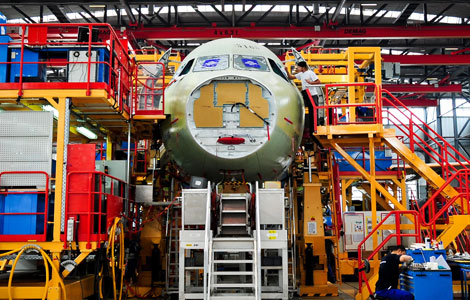Dogfight looms over jets
Updated: 2013-10-22 00:04
By Wang Wen (China Daily)
|
||||||||
 |
|
Employees work on the assembly line of the Airbus factory in Tianjin. Airbus forecast that 62 percent of the wide-body aircraft in China will work on short-haul routes by 2022. Zhang Chaoqun / Xinhua |
China will become the global battlefield for wide-body aircraft in the next decade as the country's busy airports and expanding air traffic fuel demand for more of these jets on domestic routes.
The fast-growing domestic civil aviation market is forcing Chinese airlines to use wide-body aircraft to carry more passengers on high-traffic routes between Beijing, Shanghai and Guangzhou.
Aimed at meeting this demand, Airbus SAS announced the A330 regional project at the Beijing Air Show in September with a new, lower-weight variant of its wide-body product — the A330-300.
It's the first time that the aircraft manufacturer has launched a new project in China, which will be one of the most important markets for the A330 regional.
"We see the biggest need until the end of the decade in this region," Christopher Emerson, Airbus' senior vice-president of marketing and customer affairs, said in explaining why the project was launched in China.
The A330 regional also will be available in other markets including India, Southeast Asia and Latin America, but China will be the largest market for the new aircraft in the next decade.
Airbus forecast that 62 percent of the wide-body aircraft in China will fly short-haul routes by 2022, and 274 of the aircraft will be delivered to China specifically for short-haul routes by then.
Airbus' new project has won support from Chinese authorities. It's actually a "joint idea" shared with the Civil Aviation Administration of China, Emerson said.
CAAC has always encouraged airlines to use wide-body aircraft at busy airports to relieve air traffic pressure, said Li Xiaojin, a professor at the China Aviation University in Tianjin.
"Narrow-body aircraft, which are often used on domestic routes, limited the main airports' growth in passenger throughput, as few additional slots are available at the airports," he said.
Compared with the current A330-300, the regional version with its lower weight can achieve an overall cost reduction of up to 15 percent, said Eric Chen, president of Airbus China.
The A330 regional has 400 to 440 seats, while the standard layout of the current A330 has only 300 seats.
The new version will be operated starting in 2015, but there are no orders for the aircraft so far, Chen said.
"We are contacting our consumers actively and getting positive feedback," he said, "Some leasing companies have even shown more interest than the carriers, as they are optimistic about the market for wide-body aircraft."
Five Chinese airlines were operating 122 A330-family passenger aircraft as of Sept 30.
China's A330 fleet will reach about 400 aircraft by 2020, and some of the fleet will be the regional version by then, Chen said.
Boeing Co, Airbus' main rival, is unwilling to fall behind in the domestic wide-body market.
Boeing's wide-body products, including the 787 family, the 777 family and the 747-8 aircraft, complement one another in terms of seats and range, said Darren Hulst, marketing director for Northeast Asia of Boeing commercial airplanes.
The Boeing 787 family aircraft also is suitable for domestic routes, he added.
Taking the Beijing-Guangzhou route as an example, he said, one 787-9 can save 16.5 million yuan ($2.7 million) in fuel costs each year, compared with the A330-300.
The Boeing 787-9, which will be delivered in 2014, already had received 388 orders by September.
But the A330 regional will have a 10-percent direct operating cost advantage per seat against the 787-9 in the short-range configuration, Emerson said.
The competition between the plane manufacturers in China's wide-body market will become more intense, some experts said, as their products each have advantages and disadvantages.
Chinese aircraft manufacturers also are seeking a piece of the wide-body market.
Commercial Aircraft Corp of China Ltd is doing market research into the wide-body market and is waiting for authorities' approval of its own project, according to an anonymous COMAC insider.
The entire wide-body fleet in China will reach 1,062 by 2032, COMAC said in its market outlook.
 Teacher killed, two wounded in Nevada middle school shooting
Teacher killed, two wounded in Nevada middle school shooting
 Smog wraps northeast, schools forced to close
Smog wraps northeast, schools forced to close
 Architect looks to the big picture
Architect looks to the big picture
 Teachers, students divided over Gaokao reform plan
Teachers, students divided over Gaokao reform plan
 Dogfight looms over jets
Dogfight looms over jets
 Peak season for fall foliage in Beijing
Peak season for fall foliage in Beijing
 Train carrying carrying oil, gas derails in Canada
Train carrying carrying oil, gas derails in Canada
 30,000 turn out in Beijing Marathon
30,000 turn out in Beijing Marathon
Most Viewed
Editor's Picks

|

|

|

|

|

|
Today's Top News
Obama vows to get website fixed
US OKs Alibaba structure
Economy to see 'good ending' in Q4
Teacher killed in Nevada shooting
UK official looks to China
Beijing needs to be 'more active' in global security
Border agreement to boost ties
Rising Chinese demand fuels Australia exports
US Weekly

|

|







